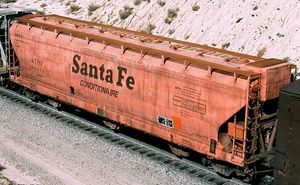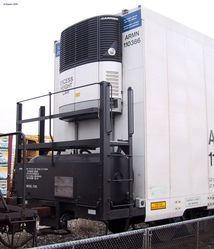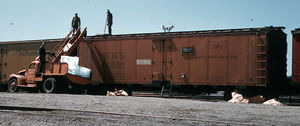Refrigerator car/Gallery: Difference between revisions
imported>Robert A. Estremo (add images) |
imported>Robert A. Estremo (relocate images / expand captions) |
||
| Line 2: | Line 2: | ||
<gallery perrow=3 widths=300px heights=250px> | <gallery perrow=3 widths=300px heights=250px> | ||
Image:Tiffany RRG 1877.jpg|{{Tiffany RRG 1877.jpg/credit}}<br />This engraving of Tiffany's original "Summer and Winter Car" appeared in the ''Railroad Gazette'' just before Joel Tiffany received his refrigerator car patent in July, 1877. Tiffany's design mounted the ice tank in a clerestory atop the car's roof, and relied on a train's motion to circulate cool air throughout the cargo space. | Image:Tiffany RRG 1877.jpg|{{Tiffany RRG 1877.jpg/credit}}<br />This engraving of Tiffany's original "Summer and Winter Car" appeared in the ''Railroad Gazette'' just before Joel Tiffany received his refrigerator car patent in July, 1877. Tiffany's design mounted the ice tank in a clerestory atop the car's roof, and relied on a train's motion to circulate cool air throughout the cargo space. | ||
Image:Armour Kansas City 3891.jpg|{{Armour Kansas City 3891.jpg/credit}}<br />A Pullman-built "shorty" reefer bears the Armour Packing Co. · Kansas City logo, ''circa'' 1885. The name of the "patentee" was displayed on the car's exterior, a practice intended to "... impress the shipper and intimidate the competition ...," even though most patents covered trivial or already-established design concepts. | Image:Armour Kansas City 3891.jpg|{{Armour Kansas City 3891.jpg/credit}}<br />A Pullman-built "shorty" reefer bears the Armour Packing Co. · Kansas City logo, ''circa'' 1885. The name of the "patentee" was displayed on the car's exterior, a practice intended to "... impress the shipper and intimidate the competition ...," even though most patents covered trivial or already-established design concepts. | ||
Image:Central Pacific Fruit Train.jpg|{{Central Pacific Fruit Train.jpg/credit}}<br />A special fast fruit train leaving Central Pacific Railroad passenger station, June 24, 1886. This train was chartered by W. R. Strong & Co. and Edwin T. Earl, fruit packers and shippers, Sacramento. | Image:Central Pacific Fruit Train.jpg|{{Central Pacific Fruit Train.jpg/credit}}<br />A special fast fruit train leaving Central Pacific Railroad passenger station, June 24, 1886. This train was chartered by W. R. Strong & Co. and Edwin T. Earl, fruit packers and shippers, Sacramento. | ||
Image:Union Refrigerator Line 6699.jpg|{{Union Refrigerator Line 6699.jpg/credit}}<br />Union Refrigerator Line refrigerator car #6699, used to transport milk, cheese, and eggs. | Image:Union Refrigerator Line 6699.jpg|{{Union Refrigerator Line 6699.jpg/credit}}<br />Union Refrigerator Line refrigerator car #6699, used to transport milk, cheese, and eggs. | ||
Image:ATSF CM type 1898.jpg|{{ATSF CM type 1898.jpg/credit}}<br />A rare double-door refrigerator car utilized the "Hanrahan System of Automatic Refrigeration" as built by ACF, ''circa'' 1898. The car had a single, centrally located ice bunker which was said to offer better cold air distribution. The two segregated cold rooms were well suited for less-than-carload (LCL) shipments. | Image:ATSF CM type 1898.jpg|{{ATSF CM type 1898.jpg/credit}}<br />A rare double-door refrigerator car utilized the "Hanrahan System of Automatic Refrigeration" as built by ACF, ''circa'' 1898. The car had a single, centrally located ice bunker which was said to offer better cold air distribution. The two segregated cold rooms were well suited for less-than-carload (LCL) shipments. | ||
Image:MDT East Rochester car shops ''circa'' 1905.jpg|{{MDT East Rochester car shops ''circa'' 1905.jpg/credit}}<br />Rows of reefers in various stages of construction fill MDT's car shop, ''circa'' 1905. | Image:MDT East Rochester car shops ''circa'' 1905.jpg|{{MDT East Rochester car shops ''circa'' 1905.jpg/credit}}<br />Rows of reefers in various stages of construction fill MDT's car shop, ''circa'' 1905. | ||
Image:Anheuser-Busch Malt Nutrine pre-1911.jpg|{{Anheuser-Busch Malt Nutrine pre-1911.jpg/credit}}<br />A pre-1911 "shorty" reefer bears an advertisement for Anheuser-Busch's Malt Nutrine tonic. The use of similar "billboard" advertising on freight cars was banned by the Interstate Commerce Commission in 1937, and thereafter cars so decorated could no longer be accepted for interchange between roads. | Image:Anheuser-Busch Malt Nutrine pre-1911.jpg|{{Anheuser-Busch Malt Nutrine pre-1911.jpg/credit}}<br />A pre-1911 "shorty" reefer bears an advertisement for Anheuser-Busch's Malt Nutrine tonic. The use of similar "billboard" advertising on freight cars was banned by the Interstate Commerce Commission in 1937, and thereafter cars so decorated could no longer be accepted for interchange between roads. | ||
Image:Interior of ice bunker reefer.jpg|{{Interior of ice bunker reefer.jpg/credit}}<br /> | Image:Interior of ice bunker reefer.jpg|{{Interior of ice bunker reefer.jpg/credit}}<br />The interior of a typical ice-bunker reefer from the 1920s; the wood sheathing would give way to plywood within twenty years. Vents in the bunker at the end of the car, along with slots in the wood floor racks, allowed cool air to circulate around the contents during transit. | ||
Image:Swift Brands Sioux City, Iowa meat packing plant.jpg|{{Swift Brands Sioux City, Iowa meat packing plant.jpg/credit}}<br />A view of the Swift Brands [[Sioux City, Iowa]] meat packing plant, ''circa'' 1917. All but one of the refrigerator cars in the photo bear the markings of the Swift Refrigerator Line. | Image:Swift Brands Sioux City, Iowa meat packing plant.jpg|{{Swift Brands Sioux City, Iowa meat packing plant.jpg/credit}}<br />A view of the Swift Brands [[Sioux City, Iowa]] meat packing plant, ''circa'' 1917. All but one of the refrigerator cars in the photo bear the markings of the Swift Refrigerator Line. | ||
Image:PFE 722.jpg|{{PFE 722.jpg/credit}}<br />Pacific Fruit Express #722, an ice-cooled, express-style refrigerator car designed to carry milk in tin-plated steel cans and other highly perishable cargo at the head end of passenger train consists. | Image:PFE 722.jpg|{{PFE 722.jpg/credit}}<br />Pacific Fruit Express #722, an ice-cooled, express-style refrigerator car designed to carry milk in tin-plated steel cans and other highly perishable cargo at the head end of passenger train consists. | ||
| Line 27: | Line 18: | ||
Image:FM REA 65.jpg|{{FM REA 65.jpg/credit}}<br />An REA express reefer is positioned at the head end of Santa Fe train No.8, the ''Fast Mail'', in 1965. | Image:FM REA 65.jpg|{{FM REA 65.jpg/credit}}<br />An REA express reefer is positioned at the head end of Santa Fe train No.8, the ''Fast Mail'', in 1965. | ||
Image:PFE 45830.jpg|{{PFE 45830.jpg/credit}}<br />A steel refrigerator car (Pacific Fruit Express #458330) sits on a siding at Denver, Colorado in March 1970. The mechanical refrigeration unit is housed at the car's "A" end, behind the grill at the lower left. | Image:PFE 45830.jpg|{{PFE 45830.jpg/credit}}<br />A steel refrigerator car (Pacific Fruit Express #458330) sits on a siding at Denver, Colorado in March 1970. The mechanical refrigeration unit is housed at the car's "A" end, behind the grill at the lower left. | ||
Image:Intermodal freight February 1995.jpg|{{Intermodal freight February 1995.jpg/credit}}<br />A westbound intermodal freight train passes through the Cajon Pass, | Image:Intermodal freight February 1995.jpg|{{Intermodal freight February 1995.jpg/credit}}<br />A westbound intermodal freight train passes through the Cajon Pass, Mile Post 54, in February 1995. | ||
Image:CRYX 2038.jpg|{{CRYX 2038.jpg/credit}}<br />Cryo-Trans (CRYX) #2038 keeps its contents cool using liquified CO<sub>2</sub>. | Image:CRYX 2038.jpg|{{CRYX 2038.jpg/credit}}<br />Cryo-Trans (CRYX) #2038 keeps its contents cool using liquified CO<sub>2</sub>. | ||
Image:TPIX 250.jpg|{{TPIX 250.jpg/credit}}<br />Tropicana refrigerated box car #250. | Image:TPIX 250.jpg|{{TPIX 250.jpg/credit}}<br />Tropicana refrigerated box car #250. | ||
| Line 35: | Line 26: | ||
Image:ARMN 110386 detail.jpg|{{ARMN 110386 detail.jpg/credit}}<br />State-of-the-art mechanical refrigerator car designs place the removable, end-mounted refrigeration unit outside of the freight compartment in order to facilitate access for servicing or replacement. | Image:ARMN 110386 detail.jpg|{{ARMN 110386 detail.jpg/credit}}<br />State-of-the-art mechanical refrigerator car designs place the removable, end-mounted refrigeration unit outside of the freight compartment in order to facilitate access for servicing or replacement. | ||
Image:MDT-GMO 12530.jpg|{{MDT-GMO 12530.jpg/credit}}<br />An early version of a field icing car loads a Merchants Despatch Transportation Co. reefer (bearing the herald of the GM&O) in Norfolk, Virginia in April 1955. | Image:MDT-GMO 12530.jpg|{{MDT-GMO 12530.jpg/credit}}<br />An early version of a field icing car loads a Merchants Despatch Transportation Co. reefer (bearing the herald of the GM&O) in Norfolk, Virginia in April 1955. | ||
</gallery> | </gallery> | ||
==Notes and references== | ==Notes and references== | ||
Revision as of 13:56, 14 August 2013
(PD) Engraving: Railroad Gazette
This engraving of Tiffany's original "Summer and Winter Car" appeared in the Railroad Gazette just before Joel Tiffany received his refrigerator car patent in July, 1877. Tiffany's design mounted the ice tank in a clerestory atop the car's roof, and relied on a train's motion to circulate cool air throughout the cargo space.(PD) Photo: Smithsonian Institution
A Pullman-built "shorty" reefer bears the Armour Packing Co. · Kansas City logo, circa 1885. The name of the "patentee" was displayed on the car's exterior, a practice intended to "... impress the shipper and intimidate the competition ...," even though most patents covered trivial or already-established design concepts.(PD) Photo: American Car and Foundry Company
A rare double-door refrigerator car utilized the "Hanrahan System of Automatic Refrigeration" as built by ACF, circa 1898. The car had a single, centrally located ice bunker which was said to offer better cold air distribution. The two segregated cold rooms were well suited for less-than-carload (LCL) shipments.(PD) Photo: American Car and Foundry Company
A pre-1911 "shorty" reefer bears an advertisement for Anheuser-Busch's Malt Nutrine tonic. The use of similar "billboard" advertising on freight cars was banned by the Interstate Commerce Commission in 1937, and thereafter cars so decorated could no longer be accepted for interchange between roads.(PD) Photo: Swift Brands
A view of the Swift Brands Sioux City, Iowa meat packing plant, circa 1917. All but one of the refrigerator cars in the photo bear the markings of the Swift Refrigerator Line.© Image: Orange Public Library
A crate label for Hewes' Transcontinental Brand of El Modena, California, circa 1930 depicts a trainload of Pacific Fruit Express (PFE) ventilated refrigerator cars passing near San Francisco Bay.(PD) Photo: William B. Barry
A Swift refrigerator car has reached the end-of-the-line at East Orange, New Jersey. The car has been repainted and was photographed in mid- or late-1937, after the use of "billboard" advertising on freight cars had been banned by the Interstate Commerce Commission, and such cars could no longer be accepted for interchange between roads.

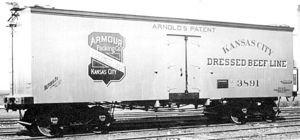

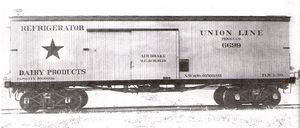

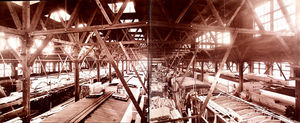
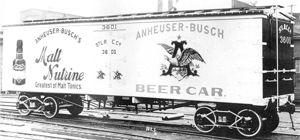
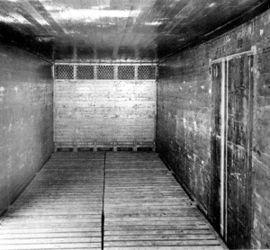
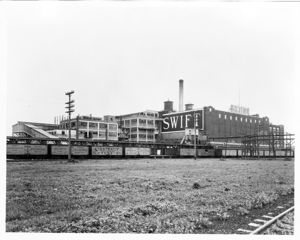
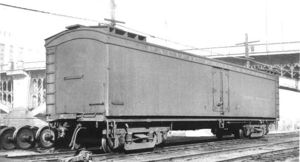


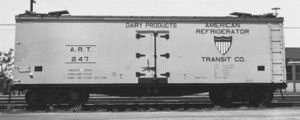
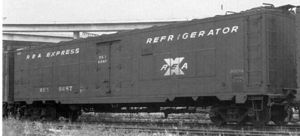
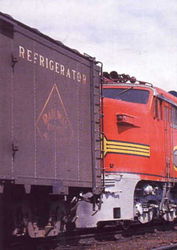
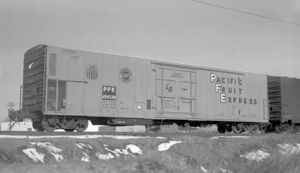
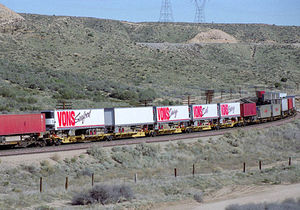
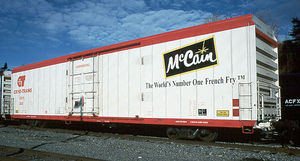
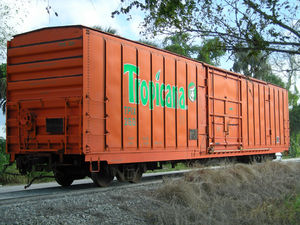

![(PD) Photo: Garitzko Outside of North America, railroad cars which have been outfitted with cooling equipment (and designated as Class "I" by the International Union of Railways [UIC]) are generally referred to as "refrigerated vans."](/wiki/images/thumb/9/92/Kuehlwagen_Interfrigo.jpg/300px-Kuehlwagen_Interfrigo.jpg)
